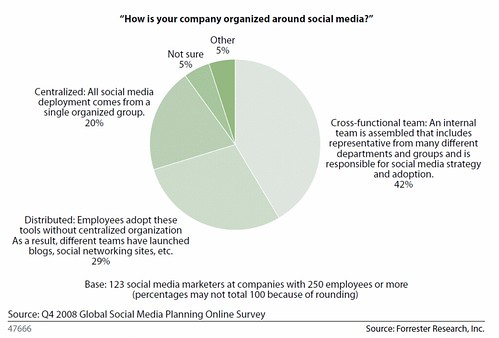I often get asked by brands: “How should we organize our company for social media?” or “Which roles do we need”, or “Which department is in charge”. So for our latest report (clients can access all the details) answers just that, it has data and graphs about spending, brand maturity in the social space, which department ‘owns’ the program, and how companies are organizing.
Companies organize in three distinct models
For this post, let’s focus in on how companies are organizing. There are three basic models that I’ve observed and surveyed brands:
- The Tire (Distributed): Where each business unit or group may create its own social media programs without a centralized approach. We call this approach the “tire,” as it originates at the edges of the company.
- The Tower (Centralized): We refer to this centralization as the “tower” – a standalone group within a company that’s responsible for social media programs, often within corporate marketing or corporate communicaitons.
- The Hub and Spoke (Cross Functional): Like the hub on a bicycle wheel, a cross-functional group that represents multiple stakeholders across the company assembles in the middle of the organization. The hub facilitates resource sharing and cross-functional communications (via the “spokes” in the wheel) to those at the edge of the organization (or the “tire”)

The above graphic shows how brands we surveyed are organized
Which way should companies organize?
We believe the most sophisticated and effecient way is the Hub and Spoke, which provides centralized resources that can support business units. The business units still have the freedom and flexibility to dialog with the market –and should be in alignment with what other spokes are doing. Social doesn’t impact one department –but impacts marketing, pr, product, services, support, and development –every customer touchpoint.
Remember: 80% is Strategy only 20% is Technology
On a related note, thanks to heavy collaboration with colleague Zach Hofer-Shall we’ve also published a report for clients on a community launch checklist. This checklist reminds brands that 80% of their success is dependent on understanding their customers, defining an objective, and assembling the right strategy that encompasses: plans, roles, process, budgets, measurement, and training –not a focus on technology.
The faster brands can realize that approaching social marketing and collaboration isn’t about technology, but about process and change management the better off they are. You’ll find simliar thoughts from David Armano –who’s scoping out different models within their framework of social business design.
Love to hear from you: Which way is your brand organized? In a tire? tower? or hub and spoke. In my experience, I often ask stakeholders in companies to vote by raising their hands on which model they think they are –most often, not everyone agrees –but most want to evolve to hub and spoke. Try polling your internal teams to start a lively discussion.
Update: David Armano responds, and points out there can be multiple hubs and spokes in a single corporation. We’ve found this in large CPG and Tech titans, this model can work well.
Funny enough when I think about, because as you shared 80% strategy/20% technology, but the hub and spoke model is basically how, in my opinion, IT departments are most effective as well – out in the field, problem-solving, efficiency-gaining for other departments.
Great post Jeremiah and I agree that this is going to be a culture change. Two big “impediments” I see are (a) the politics/bureaucracy in some organizations where ‘Marketing’ or ‘Communications’ want to take total control, and (b) a shift in the mental model of the organization and the executives from the current model to a model able to handle social media. These are interlinked and I think the faster a firm realized the benefit of collaboration, the quicker they will leverage an advantage out of the social media.
My organization is trying to empower different teams to use social media for their work, and are basically using a hub and spokes model.
The challenge remains that we have pretty tightly controlled messages and are concerned about quality control.
I’d be curious about your strategies for managing everyone’s use of social media effectively, without micromanaging.
spelt communicaitons wrong in 3rd bullet.
spelt communicaitons wrong in 3rd bullet.
It's good to know your stand towards this comment thing going on. I've visited some design sites before that I find have repetitive comments from visitors,anti keylogger might be one of those you were pertaining to.
sports shoes
Nike Sport Shoes
Women's Nike Sport Shoes
Men's Nike Sport Shoes
sports shoes
Nike Sport Shoes
Women's Nike Sport Shoes
Men's Nike Sport Shoes
I would take this a little further; the breakdown is more like;
5% technology, 20% strategy and strategy evolution
AND
75% blood, sweat and tears.
Getting set up in social media may seem like a great idea these days, but the technological and strategic processes are fairly well documented, and folks are missing the key differentiator between “traditional” marketing and social marketing. Traditionally, your conversations with your target were personal and private; in the social world, the conversation is broadcast – everywhere for all time (or at least, you should assume this is the case).
Social media marketing requires brains and hands – depending on your business, quite possibly many of them. Conversations are in real time, and the faster you reply/acknowledge, the more credibility you have (unless your brain is disengaged when you reply – in which case, you're pooched!)
More succinctly;
Prepare for a significant labor and management cost well in excess of your strategic development and technology costs.